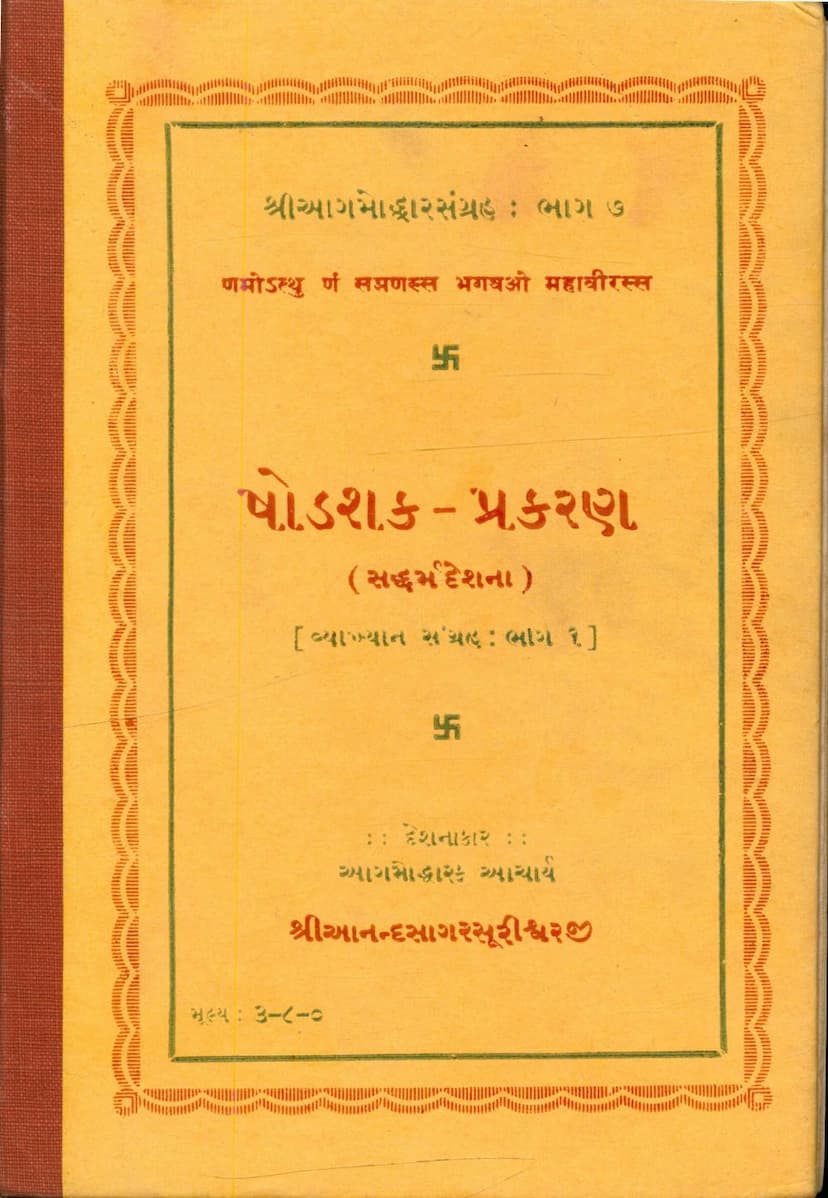Shodashak Prakaran
Added to library: September 2, 2025

Summary
Here's a comprehensive summary of the Jain text "Shodashak Prakaran" by Anandsagarsuri, based on the provided text:
Book Title: Shodashak Prakaran (specifically, the section titled "Saddharma Deshana" which is a discourse on true dharma) Author: Acharya Shrimad Anandasagarsuri (as the commentator/preacher) Original Work: Shodashak Prakaran by Haribhadrasuri Publisher: Jain Pustak Pracharak Samstha Catalog Link: https://jainqq.org/explore/022319/1 Volume: Shri Agamoddhar Sangrah, Part 7 (This particular discourse is part of a larger collection of teachings) Language: Gujarati (with Sanskrit verses and technical terms) Publication Year: Vikram Samvat 2005 / Vir Samvat 2475 (corresponding to approximately 1948 CE)
Core Content and Purpose:
The book presents a series of 23 discourses (Vyakhyanas) given by Acharya Shrimad Anandasagarsuri on the 12th verse of the second "Shodashak" (a section of 16 verses) from Haribhadrasuri's original "Shodashak Prakaran." The central theme is the exposition of Saddharma (true dharma) through the detailed explanation of this specific verse. The discourses aim to elucidate the principles of Jainism, emphasizing the importance of understanding and practicing dharma through its essence.
Key Themes and Concepts Discussed in the Discourses (as inferred from the Vyakhyana titles and Professor Kapadia's preface):
The summary of the content is extensive, drawn from Professor Hiralal Rasikdas Kapadia's preface and the detailed table of contents. The discourses cover a wide range of philosophical, ethical, and practical aspects of Jainism, often contrasting Jain viewpoints with those of other traditions. Here are some of the prominent themes:
- The Nature of Dharma and True Conduct: The central idea is that true dharma lies in the "Vachnaradhana" (adherence to the word/teachings) of the Tirthankaras and living according to those principles. The discourses explain that mere ritualistic actions are insufficient; the practice must be aligned with the authentic teachings.
- Distinguishing the Temporal from the Eternal: The discourses emphasize the need to prioritize future spiritual well-being over immediate worldly pleasures. This is illustrated through the concept of living in a way that builds a "palace" for the soul in the afterlife, rather than a "jail" of worldly existence.
- The Role of Intellect and Understanding: The discourses highlight the importance of discerning intellect ("Buddhi") in understanding dharma. They differentiate between a childlike understanding, a moderate understanding, and a true discerning intellect that grasms the essence of reality.
- The Concept of "Arya" and "Anarya": The text delves into the definitions of "Arya" (noble/virtuous) and "Anarya" (ignoble/unvirtuous). This is explained through various lenses: adherence to ethical codes (non-violence, truthfulness), the presence of Tirthankaras and enlightened beings in a region, and a general inclination towards dharma.
- The Nature of the Soul (Jiva) and Karma: The discourses differentiate Jain beliefs about the soul and its interaction with karma from other philosophies. Jainism asserts the soul's inherent purity and its capacity for liberation, contrasting this with views that see the soul as inherently bound to karma or dependent on an external deity for salvation.
- The Concept of God/Tirthankara: The text discusses the Jain understanding of Tirthankaras not as creators, but as perfect beings who have achieved liberation and guide others. Their significance lies in their perfect knowledge and conduct, making them the ultimate role models.
- The Importance of Vachnaradhana (Adherence to Teachings): A recurring theme is that true dharma is found in following the word of the Tirthankaras. This involves not just intellectual understanding but also practical adherence and internalizing the teachings.
- Distinction between Different Schools of Thought: The discourses engage in critical analysis, often implicitly or explicitly comparing Jain principles with those of Brahmanical, Buddhist, and other philosophical traditions, highlighting the uniqueness of the Jain path.
- Practical Guidance and Ethical Conduct: The discourses offer practical advice on ethical living, emphasizing concepts like non-violence (Ahimsa), non-attachment (Aparigraha), self-control (Sanyam), and righteous conduct.
- The Nature of Liberation (Moksha): The ultimate goal of liberation is presented as the soul's inherent state of perfection, freed from the cycles of birth and death and the influence of karma.
- The Role of Karma and Its Cessation: The text discusses how karma binds the soul and the various paths (like penance, asceticism, righteous conduct) to shed karma and attain liberation.
- Metaphorical Illustrations and Stories: The discourses employ numerous analogies, stories, and examples from everyday life, scripture, and history to make complex philosophical concepts understandable and relatable.
Structure of the Book:
- Preface (Prastavana): A significant portion of the book is dedicated to Professor Hiralal Rasikdas Kapadia's preface, which provides a detailed introduction to Acharya Anandasagarsuri, his work, the original author Haribhadrasuri, and the "Shodashak Prakaran" itself. This preface serves as a biographical and critical foundation for the text.
- Table of Contents (Vishay Suchi / Vishayanukram): A comprehensive list of the 23 discourses, detailing the topics covered in each Vyakhyana.
- Errata (Shuddhipatraka): Corrections for any printing or typographical errors.
- Main Body: The 23 discourses delivered by Acharya Anandasagarsuri.
- End Matter: Citations of sources (Sakshi Granth), indexes, and acknowledgments.
Significance:
This work is valuable for its detailed philosophical exposition of Jain principles, presented through the accessible and insightful commentary of a renowned modern Acharya. It aims to guide individuals towards understanding and practicing true dharma, ultimately leading to spiritual liberation. The preface by Professor Kapadia adds academic weight and context, highlighting the scholarly contributions of Acharya Anandasagarsuri. The extensive index of topics indicates the breadth and depth of the spiritual guidance offered.